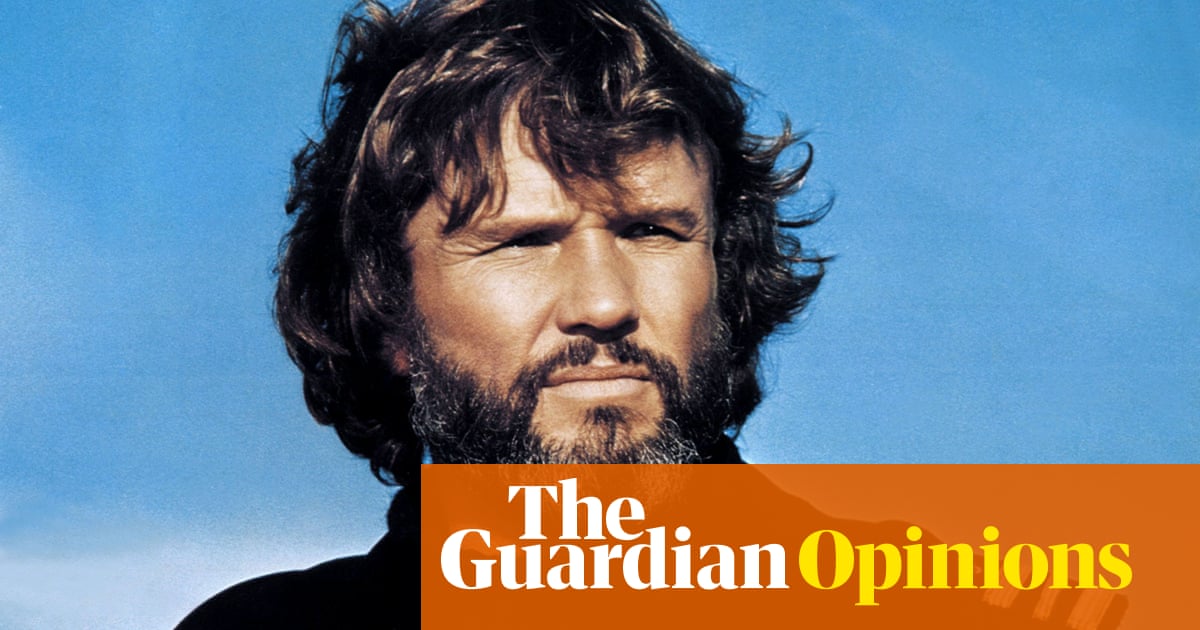If Kris Kristofferson had never sung a single note, he would still have been remembered as a terrific screen actor in the Hollywood tradition of tough frontier masculinity, a movie star who worked with Scorsese, Peckinpah, Cimino and Sayles. He had a natural, unforced charisma in the rugged, take-it-or-leave-it tradition of Robert Ryan or John Wayne, or the newer style of Jeff Bridges and Sam Elliott.
Actually, without his recording career, he might have made it higher in the pantheon of screen legends, and his movie work was perhaps one of the casualties of Michael Cimino’s colossal folie de grandeur epic Heaven’s Gate from 1980, which damaged the prestige of everyone involved – Kristofferson was cast, or even miscast, a little against type as a Harvard man and member of the American overclass, who gallantly takes the side of immigrant homesteaders against the cruel cattle barons. It would have been interesting to see him to swap roles with Christopher Walken who was the barons’ hired gun – although Kristofferson made sense of the role’s need for granite integrity.
His face had a naturally Mount Rushmore-type impassive quality and he moved with an unhurried ranginess, the kind of walk which is designed to have a gun belt slung diagonally across the hips, although Kristofferson was never the cliched western archetype, and his speaking voice was the rumbling, compelling equivalent of his singing. He worked with Sam Peckinpah on three films, although maybe his most Peckinpah-type of character, one which he had had to grow into, was the notoriously violent and racist sheriff Charlie Wade, seen in flashback in John Sayles’ 1996 western crime drama Lone Star. His face had a natural reserve, even enigma, a guy who isn’t going to lay himself out there and ask for favours (with Kristofferson, you think of Ronald Reagan’s dictum “If you’re explaining, you’re losing”) but with a tiny half-smile could suggest menace and imminent violence.
In his undemonstrative way, Kristofferson was as much a lover as a fighter on screen – although the template was set with his role in Martin Scorsese’s Alice Doesn’t Live Here Anymore from 1974: he was never precisely the boyish romantic. Ellen Burstyn is the widowed single mother and wannabe singer in retreat from the perils of life; she comes across Kristofferson’s divorced guy in a diner who becomes a kind of husband and stepfather, but rough and weather-beaten, with plenty of flaws and no illusions. An unusual variant on this was the British-set movie The Sailor Who Fell From Grace With the Sea from 1976, based on the Mishima novel in which Kristofferson is the sailor in the merchant navy who charms Sarah Miles and upsets her son – again, he is independent and freewheeling, with a very complicated attitude to the whole idea of settling down, despite his obvious plausibility as old-school breadwinner and protector.
In Sam Peckinpah’s Pat Garrett & Billy the Kid in 1973, his Billy the Kid faces off against Garrett, played by James Coburn – another great strong-silent exemplar, although unusually Kristofferson is clean-shaven here, revealing something oddly cherubic in his face. But there was nothing cherubic about his appearance in Peckinpah’s Bring Me the Head of Alfredo Garcia a year later, playing the fully bearded and fully violent biker-killer and enthusiastic participant in Peckinpah’s characteristically choreographed brutality.
For Peckinpah’s Convoy (1978), based on the hit single and the short-lived craze for CB radio, Kristofferson was the good guy, the neo-cowboy trucker (and lover) whose freedom on the open roads is threatened by corrupt law enforcement. It was a counterculture role, in its proto-Maga way, rather like his weed-selling musician in Cisco Pike (1971) being harassed by Gene Hackman’s cop.
Perhaps Kristofferson reached, or should have reached, a kind of screen apotheosis in the sensational box-office smash A Star Is Born from 1976, in which Kristofferson plays the established rock star who mentors and falls in love with a sensationally talented singer, played by Barbra Streisand, whose career goes stratospheric just as his plummets. The poster showed their two faces in a steamy Joy-of-Sex type clinch, but it’s debatable as to how convincingly Kristofferson could be as the embarrassingly wounded and downwardly-mobile loser. Could he fully commit to the darker aspects of the role embraced by the other actors who played it, like James Mason opposite Judy Garland in 1954 or Bradley Cooper opposite Lady Gaga in 2018? Well, Cooper’s gravelly, slow-talking performance was obviously very much indebted to Kristofferson and perhaps Kristofferson didn’t need to emote: merely being there and coming off second best to Barbra Streisand – a performer with no intention of being upstaged by her alpha male co-star – was spectacle enough.
Kristofferson was a performer who put the heady flavour of whisky and chewing tobacco into the movies: he was always the real deal.

